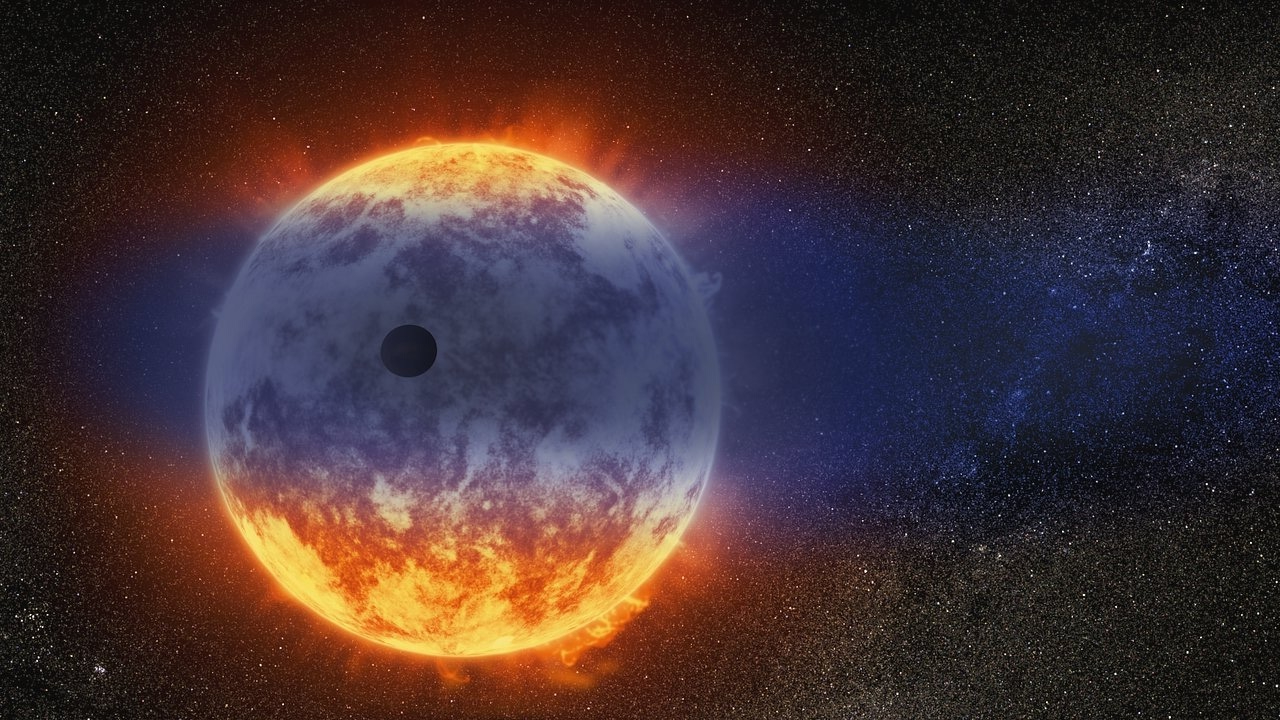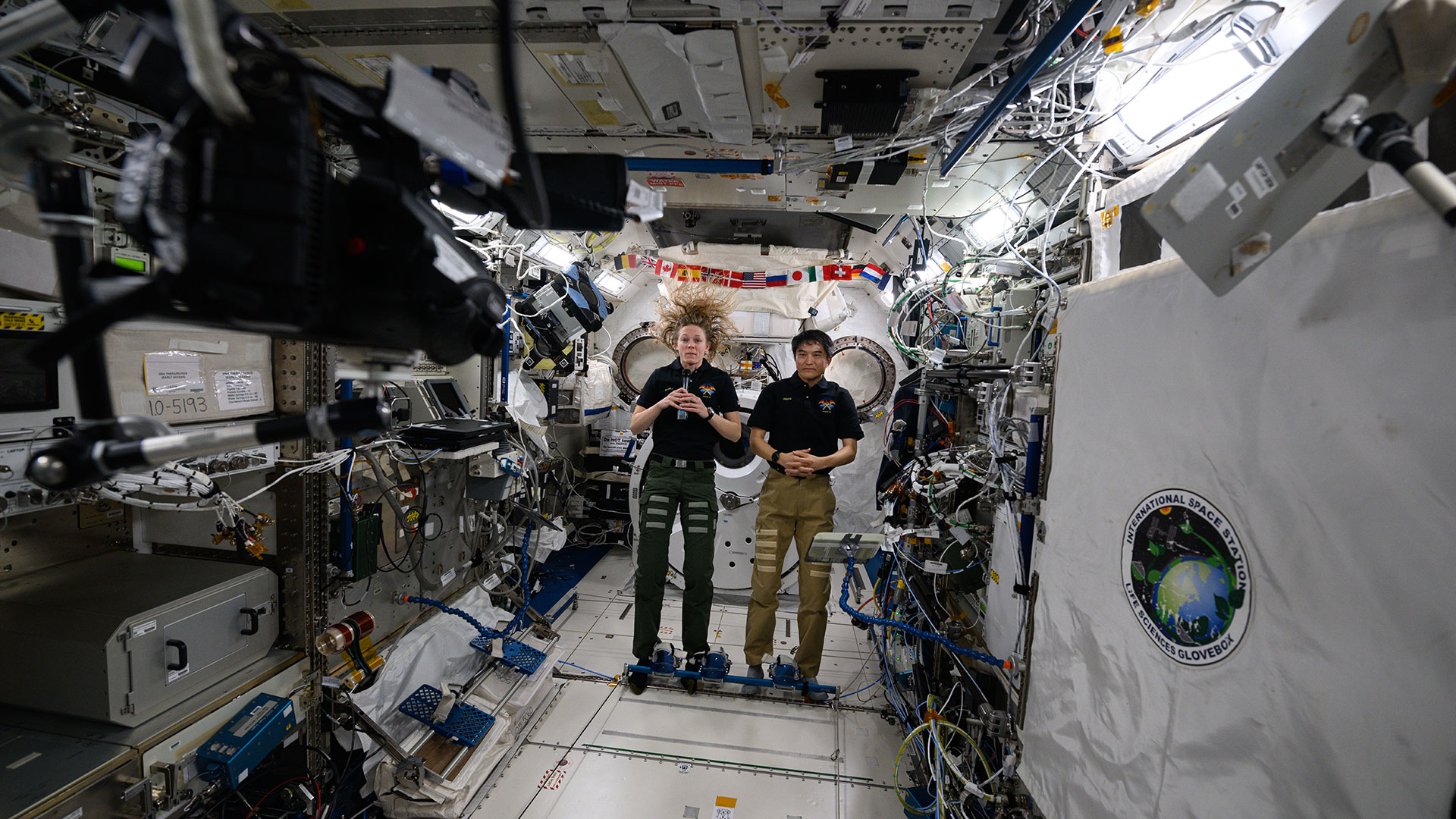Scientists find a surprise ingredient in exoplanet cake mix — sulfur dioxide
Exoplanet GJ 3470b, is a weird sulfurous world that orbits over its star's poles.

A 'hot Neptune' exoplanet has been found to contain sulfur dioxide in its atmosphere — an atmosphere that's also gushing into space as the planet loops over its star's poles on a steeply inclined orbit every three-and-a-third days.
The existence of sulfur dioxide in the atmosphere of the exoplanet, dubbed GJ 3470b and located 96 light-years from Earth, came as a shock when it was spotted by the James Webb Space Telescope (JWST).
"We didn't think we'd see sulfur dioxide on planets this small, and it's exciting to see this new molecule in a place we didn't expect, since it gives us a new way to figure out how these planets formed," sThomas Beatty of the University of Wisconsin, Madison said in a statement. "And small planets are especially interesting, because their compositions are really dependent on how the planet-formation process happened."
Everything about GJ 3470b tells us it has a fascinating and eventful history.
Planets form in a disk of gas and dust that swirls around a plane aligned with a star's rotational axis. In our solar system, we can see evidence of this disk in that all the planets from Mercury to Neptune orbit in the ecliptic plane. GJ 3470b, on the other hand, follows a path inclined by 89 degrees to the rotational axis of its cool red dwarf star. In other words, it's on a steep orbit that loops over the star's poles. Planets don't typically form on such orbits.
Related: Why are there so few 'hot Neptune' exoplanets?
With a mass 13.9 times greater than Earth's mass, and a diameter about 40% that of Jupiter, GJ 3470b is a bloated gas bag. When such worlds are close to their star, astronomers call them 'hot Neptunes." GJ 3470b has an atmospheric temperature of 325 degrees Celsius (617 degrees Fahrenheit); the temperature of Neptune in our solar system is –200 degrees Celsius (–330 degrees Fahrenheit).
Get the Space.com Newsletter
Breaking space news, the latest updates on rocket launches, skywatching events and more!
Present models of planet formation describe how gas giants typically form farther out from their star than rocky planets, in the cold depths where gas is more plentiful. Yet, GJ 3470b orbits at a distance of just 5.3 million kilometers (3.3 million miles) from its star. For comparison, Mercury, the closest planet to our sun, orbits at an average distance of 58 million kilometers (36 million miles) from our star, although red dwarf systems are usually scaled down compared to our solar system.
Ordinarily, we would expect GJ 3470b to have formed farther out and then migrated inward as a result of interactions with its star's planet-forming disk. Meanwhile, scientists would normally suspect the world would've been shoved out of the orbital plane via a gravitational interaction with another planet, or perhaps even upheaval caused by a close-passing star.
However, the planet's atmospheric mix suggests otherwise.
Despite the JWST's detection of molecules within, such as sulfur dioxide, GJ 3470b's atmosphere remains overwhelmingly made from hydrogen and helium, even more so than the gas planets in our solar system — a fact discerned by the Hubble Space Telescope in 2019. So, the explanation put forward is that GJ 3470b actually formed close to its star as a rocky planet before accruing a thick atmosphere of almost pure hydrogen and helium — but, at the moment, this is just a hypothesis. That's why the JWST's detection of sulfur dioxide is so important, because its presence could help differentiate between different theories of how the planet formed.
The sulfur dioxide detection came to light thanks to the fact that GJ 3470b transits its star, which allows astronomers to conduct what's called "transmission spectroscopy." As light from its parent star shines through itsthe GJ 3470b's atmosphere, molecules in the world's atmosphere absorb some of the starlight, leaving dark absorption lines in the star's spectrum.
Teasing out these absorption lines is difficult, however, especially for a hot Neptune that is likely covered in featureless haze.
"The thing is, everybody looks at these planets and often everybody sees flat lines," said Beatty. "But when we looked at this planet, we really didn't get a flat line."
Instead, the JWST was able to confirm absorption lines from carbon dioxide, methane and water vapor, and indeed detect sulfur dioxide in the region for the first time. This actually makes GJ 3470b the lightest and coldest exoplanet yet known to have sulfur dioxide in its atmosphere. Previous detections have related to the atmospheres of hot Jupiters with temperatures above a thousand degrees Celsius (1,830 degrees Fahrenheit).
"Discovering sulfur dioxide in a planet as small as GJ 3470b gives us one more important item on the planet-formation ingredient list," said Beatty.
The sulfur probably began as a component in hydrogen sulphide, the team believes. However, because GJ 3470b orbits so closely to its star, ultraviolet light from the stellar body packs a powerful-enough punch to break atmospheric molecules apart with ease, leading to a kind of chemical churn formed from smashed molecular components recombining with other atoms and molecules. A sulfur atom combined with two oxygen atoms forms sulfur dioxide.
The planet's parent star doesn't just break up atmospheric molecules, however; hydrogen liberated from those molecules can be stripped them from the planet entirely. GJ 3470b is therefore literally evaporating before our very eyes, the stellar wind gradually blowing its atmosphere away into space, leaving a stream of hydrogen gas trailing behind. Already, the planet has lost an estimated 40% of its original mass.
The presence of sulfur dioxide in its atmosphere, the inclined orbit that remains unexplained and the mass loss that is dramatically changing GJ 3470b forever are significant clues as to the origin of this weird and wonderful planet, according to Beatty.
"Those are important steps in the recipe that created this particular planet and can help us understand how planets like it are made," he said.
Beatty presented the results at the 244th meeting of the American Astronomical Society on June 10, and they have been accepted for publication in Astrophysical Journal Letters.
Join our Space Forums to keep talking space on the latest missions, night sky and more! And if you have a news tip, correction or comment, let us know at: community@space.com.

Keith Cooper is a freelance science journalist and editor in the United Kingdom, and has a degree in physics and astrophysics from the University of Manchester. He's the author of "The Contact Paradox: Challenging Our Assumptions in the Search for Extraterrestrial Intelligence" (Bloomsbury Sigma, 2020) and has written articles on astronomy, space, physics and astrobiology for a multitude of magazines and websites.
-
Helio Nice to see science progressing where more elements are detectable in exo atmospheres. This is essential to find real "habitability".Reply
As for sulfur, it's hard to not think about Io and all its sulfur. It seems very likely it and Jupiter formed outside the frost line, allowing so much H & He to make Jupiter so massive. So wouldn't an exo like this one not have migrated from outside the frost line, too.? Interesting to ponder.
